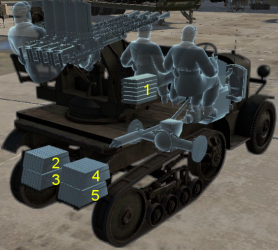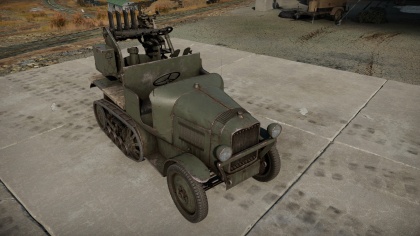Difference between revisions of "P.7.T AA"
(→Media: Added skin + video) |
(→See also: Added vehicles) |
||
| Line 184: | Line 184: | ||
== See also == | == See also == | ||
| − | ''Links to the articles on the War Thunder Wiki that you think will be useful for the reader, for example:'' | + | <!-- ''Links to the articles on the War Thunder Wiki that you think will be useful for the reader, for example:'' |
| + | * ''reference to the series of the vehicles;'' | ||
| + | * ''links to approximate analogues of other nations and research trees.'' --> | ||
| − | * | + | ;Other vehicles of similar configuration and role |
| − | * | + | * [[M13 MGMC]] |
| + | * [[GAZ-AAA (DShK)]] | ||
== External links == | == External links == | ||
Revision as of 13:44, 4 December 2020
Contents
Description
The Citroen Kegresse P.7.T is a rank French self-propelled anti-aircraft vehicle
with a battle rating of (AB), (RB), and (SB). It was introduced in Update 1.75 "La Résistance". With its four 13.2 mm Hotchkiss Mle 1930 machine guns, it poses a certain threat to enemy aircraft while featuring poor mobility (off-road) and armour.
The P.7.T AA is a very classic interwar anti-air defence system with its guns mounted on a mobile but vulnerable chassis.
With only 3 exposed crew members, anything can damage, disable or destroy this vehicle. Its armour does not provide enough cover to the crew from any angle. Even .30 cals guns can easily destroy this vehicle, so be sure to stay out of sight from enemies.
The half-track configuration usually provides increased off-road mobility to wheeled vehicles while enabling to carry more weight over the tracked section, a rule to which the P.7.T AA is no exception: It can reliably move itself across any rough terrain. The only downside to this vehicle is its low HP, which makes hill climbing quite slow. This little engine also struggles to bring this much weight to its max speed: One should go downhill and hit the gas in order to reach 40 km/h. Turning on the spot is also a no-go since the tracks do not provide enough traction to the ground: Hit the forward key and gain some speed before attempting any manoeuvre. Be patient and choose your path wisely and you should reach your destination soon enough.
With its four HMGs, this SPAA is quite reminiscent of the GAZ-AAA (4M) while having much more firepower. Since these weapons fire simultaneously, one hit usually means four holes in your opponent, a heavy toll to the early planes (and biplanes) you will be shooting at this BR.
General info
Survivability and armour
Armour type:
- Structural steel (chassis, gun mount)
- Wheel (front tires)
| Armour | Front (Slope angle) | Sides | Rear | Roof |
|---|---|---|---|---|
| Chassis | 3 mm | N/A 3 mm Engine hood | ||
| Gun Mount | 30 mm Base 20 mm Frame |
N/A | ||
Notes:
- Front tires are 10 mm thick.
- The gun platform is 100 mm thick (wood).
- Suspension wheels are 15 mm thick while tracks are 7 mm thick, and torsion bars are not modeled.
- A 3 mm plate separates the driver cabin fro the gun platform.
The P.7.T AA has practically no armour. Every crew member sits exposed to enemy fire, so even a light machine gun can knock out the entire crew in a matter of seconds. This means that the P.7.T AA should never be expected to sustain any enemy fire, including artillery barrages, strafing attacks from aircraft, and of course enemy ground fire. The only parts of the vehicle that might stop a rifle-calibre round are the engine block and gun housing, but still expect for the vehicle to be destroyed by any sort of incoming fire.
Mobility
| Game Mode | Max Speed (km/h) | Weight (tons) | Engine power (horsepower) | Power-to-weight ratio (hp/ton) | |||
|---|---|---|---|---|---|---|---|
| Forward | Reverse | Stock | Upgraded | Stock | Upgraded | ||
| Arcade | Expression error: Unexpected * operator. | 28 | Expression error: Unexpected round operator. | __.__ | |||
| Realistic | 18 | Expression error: Unexpected round operator. | __.__ | ||||
The mobility is above average and smooth overall, while no terrain poses a challenge due to the half-track system. Due to the relatively high potential speed, the P.7.T AA can quickly get into an advantageous position on the map to shoot down planes. Just be sure to keep an eye out for flanking light tanks or fast medium tanks such as the Panzer III and IV, as anything can annihilate you with mere MG fire.
Armaments
Main armament
The quad 13.2 mm Hotchkiss HMG's are fantastic at shredding planes and start fires very easily due to the belts containing pure API rounds. With their above-average fire rate, high damage, good accuracy and decent reload speed, they are an AA jockey's dream. It is worth noting that they have a limited magazine capacity, only 30 rounds per gun, but this is more-or-less remedied by the fact that there are 4 guns, allowing for 120 rounds total.
However, due to the P.7's low BR, they can be decent at destroying reserve and 1.3 tanks from the sides and rear. It is not recommended to use it in this fashion, as you leave yourself as an easy target for anything with guns.
| 13.2 mm Hotchkiss Mle 1930 (x4) | Turret rotation speed (°/s) | Reloading rate (seconds) | ||||||||||||
|---|---|---|---|---|---|---|---|---|---|---|---|---|---|---|
| Mode | Capacity (Belt) | Fire rate | Vertical | Horizontal | Stabilizer | Stock | Upgraded | Full | Expert | Aced | Stock | Full | Expert | Aced |
| Arcade | 1,440 (30) | 450 | -10°/+45° | ±180° | N/A | 52.84 | 73.13 | 88.80 | 98.20 | 104.47 | 7.80 | 6.90 | 6.36 | 6.00 |
| Realistic | 35.70 | 42.00 | 51.00 | 56.40 | 60.00 | |||||||||
Ammunition
- AP-T: AP-I · API-T
| Penetration statistics | |||||||
|---|---|---|---|---|---|---|---|
| Belt | Penetration @ 0° Angle of Attack (mm) | ||||||
| 10 m | 100 m | 500 m | 1,000 m | 1,500 m | 2,000 m | ||
| AP-T | 24 | 23 | 14 | 10 | 7 | 4 | |
Ammo racks

| Full ammo |
1st rack empty |
2nd rack empty |
3rd rack empty |
Visual discrepancy |
|---|---|---|---|---|
| 48 | 44 (+4) | 28 (+20) | 4 (+44) | No |
Usage in battles
Overview:
The P.7.T AA has a total lack of armour, so the best strategy is to stay away from enemy ground vehicles and focus on planes. However, the guns do have some penetration, so targeting enemy ground vehicles is a possibility. The limited mobility and lack of armour make fighting enemy ground vehicles very difficult for the P.7.T AA.
Tips:
Playing the P.7.T by focusing on air targets is the most viable strategy. Do not spawn this vehicle early game since there will be few planes to shoot at. Do not engage aircraft too early, as you will only expose yourself. Begin firing at less than 1 km range for the best effect. Always watch out for multiple aircraft, as if they strafe you, you will almost certainly die. The guns are surprisingly potent, and will quickly dispatch most air targets after a few hits, although some heavy fighters and bombers may prove challenging to destroy. When engaging enemy tanks, you can reverse from behind a building to only expose the gunner to enemy fire.
Modules
| Tier | Mobility | Protection | Firepower | |
|---|---|---|---|---|
| I | Tracks | Parts | Horizontal Drive | |
| II | Suspension | Brake System | FPE | Adjustment of Fire |
| III | Filters | Crew Replenishment | Elevation Mechanism | |
| IV | Transmission | Engine | Artillery Support | |
Pros and cons
Pros:
- Four 13.2 mm machine guns, able to destroy weakly armoured foes like the Ha-Go, AS 42 or T-26, and aircraft like the He 51
- AP-I/API-T belt as default means it has anti-tank potential even when stock
- Excellent at actually being an SPAA. A high rate of fire and powerful rounds will shred planes at the rank
- Good at suppressing enemy vehicles
- Light: easy to tow from enemy fire when immobilised
- Can damage some tanks from their weaker sides, like the LVT(A) series, Pz.IV C or Pz.II
- Does not lose too much speed when turning due to the half-track configuration
Cons:
- Very low survivability - the crew is exposed, extremely vulnerable to anything especially enemy MG, nearby artillery, bombs and rockets and HE shrapnels, even 7.62 mm MGs can damage critical parts like the engine or transmission
- Has difficulty penetrating most enemy tanks frontally, for example Pz.II, B1 bis
- Reload time is rather long, stopping it from firing back in critical times
- Poor off-road mobility and climbing ability makes it slow on hills
- The four canons fire synchronously, which reduces the chances to hit an aircraft
- Gun platform turning and elevation rate are a bit slow (slow reaction, hard to follow close/fast targets)
- Limited elevation of 45° limits its effectiveness against targets directly above it, for example dive bombers like Ju 87 B2* Driver blocks the gun in a frontal ~90° arc, may not be able to swing the hull around in time to combat sudden encounters
History
The first half-tracks were built by Frenchman Adolphe Kegresse for Russia in 1910-11. After the First World War Kegresse returned to France to work with Citroen to produce half-tracks for the French Army starting in the 1920s. By 1940, these unarmoured Kegresse-Citroen half-tracks (the P.17, P.19, P.107, and MCG variants) were used primarily for towing artillery, although a small number of closed-top half-track armoured cars (the P.16) were also in service. The P.7.T had been an earlier Kegresse model, built between 1925 and 1927. The French, who had created the first self-propelled anti-aircraft gun-truck back in 1913, would continue through the interwar period experimenting with various truck-mounted AA weapons like those shown in this model.
Media
- Skins
- Videos
See also
- Other vehicles of similar configuration and role
External links
Paste links to sources and external resources, such as:
- topic on the official game forum;
- encyclopedia page on the tank;
- other literature.
| France anti-aircraft vehicles | |
|---|---|
| Wheeled/Half-tracked | P.7.T AA · CCKW 353 AA · TPK 6.41 |
| AMX-13 Derivatives | VTT DCA · AMX-13 DCA 40 |
| Radar SPAAG | AMX-30 S DCA |
| Missile SPAA | SANTAL · Roland 1 · ▄ItO 90M |
| Other | AMX-10P |





